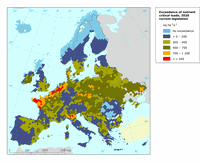
The results were computed using the 2008 Critical Loads database hosted by the Coordination Centre for Effects (CCE).

The results were computed using the 2008 Critical Loads database hosted by the Coordination Centre for Effects (CCE).

The results were computed using the 2008 Critical Loads database hosted by the Coordination Centre for Effects (CCE).

The results were computed using the 2008 Critical Loads database hosted by the Coordination Centre for Effects (CCE).

The results were computed using the 2008 Critical Loads database hosted by the Coordination Centre for Effects (CCE).

The results were computed using the 2008 Critical Loads database. Deposition data was made available by the LRTAP Convention EMEP Centre for Integrated Assessment Modelling (CIAM) at the International Institute for Applied Systems Analysis (IIASA) in autumn 2007.

The results were computed using the 2008 Critical Loads database. Deposition data was made available by the LRTAP Convention EMEP Centre for Integrated Assessment Modelling (CIAM) at the International Institute for Applied Systems Analysis (IIASA) in autumn 2007.

Hettelingh J-P, Posch M, Slootweg J (eds.) (2008) Critical load, dynamic modelling and impact assessment in Europa: CCE Status Report 2008, Netherlands Environmental Assessment Agency.

Estimated trend in AOT40 for crops values (May-July) at stations operational during the period 1996-2008. Only rural background stations are included. Note that at more than 90 % of the stations no significant up- or downward trend has been estimated.

The results were computed using the 2008 Critical Loads database. Deposition data was made available by the LRTAP Convention EMEP Centre for Integrated Assessment Modelling (CIAM) at the International Institute for Applied Systems Analysis (IIASA) in autumn 2007.

The results were computed using the 2008 Critical Loads database. Deposition data was made available by the LRTAP Convention EMEP Centre for Integrated Assessment Modelling (CIAM) at the International Institute for Applied Systems Analysis (IIASA) in autumn 2007.

The results were computed using the 2008 Critical Loads database. Deposition data was made available by the LRTAP Convention EMEP Centre for Integrated Assessment Modelling (CIAM) at the International Institute for Applied Systems Analysis (IIASA) in autumn 2007.

The results were computed using the 2008 Critical Loads database. Deposition data was made available by the LRTAP Convention EMEP Centre for Integrated Assessment Modelling (CIAM) at the International Institute for Applied Systems Analysis (IIASA) in autumn 2007.

Greenhouse gas emissions in EEA-32 countries: Absolute change 1990 - 2010

The final emission levels allocated to the EU and each Member State were established after completion of the reviews of the initial reports pursuant to Article 8 of the KP in 2008. To account for Denmark's exceptionally low base-year emissions compared to other years, Denmark received 5 million AAUs from the Union registry for the first commitment period under the KP

* 'EU‑15 (no over achievement)' corresponds to the situation of the EU‑15 where all surplus Kyoto units from target over achievement in the EU‑15 are not taken into account, to reflect the possibility that Member States with a surplus could use any remaining allowances for their own purposes and not necessarily make them available to compensate for Member States with a shortfall.
Subsequent to the effect of allocation of allowances to the EU ETS, the target and annual emissions are those of the sectors not covered by the EU ETS. The target for non-ETS sectors corresponds to the difference between the initial permissible emissions and the amount of allowances allocated under the EU ETS.
A positive value indicates a country for which average 2008–2011 non‑ETS emissions were lower than the annual target.
The assessment is based on average 2008–2011 emissions and the planned use of flexible mechanisms, as well as the expected effect of LULUCF activities.
EU‑15 values are the sum of the gaps/surplus for the 15 EU Member States party to Burden-Sharing Agreement.
For Croatia, Iceland and Switzerland, total emissions are used as they have currently no installations under the EU ETS.

Progress calculated based on domestic emissions only, without accounting for possible use of flexibility options. The 2020 targets and 2005 non‑ETS emissions are all consistent with 2013–2020 ETS scope, i.e. they take into account the extension of the ETS scope in 2013 and the unilateral inclusion of installation in 2008–2012. Relative gaps are calculated as a ratio between the difference (projected non‑ETS 2020 emissions – estimates of 2020 targets under the ESD) and EEA estimates of 2005 non‑ETS emissions consistent with 2013–2020 ETS scope

The ETS sector category '99. Other activities opted-in' is not included, as it is heterogeneous and includes installations with unclear sector definition. Figures for the sector are reported in Table 4.4 in the report

The EUA prices reflect daily over-the-counter (OTC) closing prices for EUAs to be delivered at the end of 2012

-